Data reveals the first three minutes of the OM collapse: Who pulled the "death trigger"?

Reprinted from panewslab
04/16/2025·4DAuthor: ltrd
Compiled: Tim, PANews
OM (Mantra) plummeted nearly 95% in a series of extremely unusual and highly-watched market events. I collected information from many parties as much as possible and carefully looked at the relevant data. In the analysis of the following article, I will gradually sort out the possible reasons behind this plunge.
I will explain:
- Why is OKX not the source of this sell-off (although this is the allegation I first heard)?
- Why do some people sell OM tokens like the end of the world?
- Why is a wallet that started pledging OM 448 days ago directly related to this incident?
In the first part, we will focus on the microstructure of the market and how to correctly analyze such events. I'll then outline how the whole situation might unfold and which characters might play a key role in it.
It must be clear that:
- This sell-off is by no means "ordinary", even in the cryptocurrency market.
- Its scale is so huge and chaotic that in my opinion, it has pushed many market participants to the brink of liquidation. This is clearly visible in both order book data and capital flows.
- In addition, this is just my personal understanding of the incident. These are not formal allegations, and you do not expect to regard anything described here as absolute truth.
No one knows exactly what happened except—perhaps—that is only a few insiders.
I hope you can read my content with a critical attitude. If you find any inconsistencies in my logic or analysis, be sure to point them out. I share these out of goodwill and aim to show how complex transaction events are handled. Of course, it's because I enjoy it.
Quick review of OM plunge event
At around 19:30 (UTC) on April 14, the token OM suffered a large-scale sale, and the token has been listed on almost all mainstream exchanges, including the perpetual contract market. It should be noted that the existence of its perpetual contract market is an important detail.
Before the crash, OM ranked in the top 25 cryptocurrency market capitalization rankings. However, in just a few hours, its price plummeted by about 95%, of which it had plummeted by nearly 90% in just one hour.
Such fluctuations are amazing even for low-market altcoins that rank outside of the 2000s, not to mention the top 25 currencies.
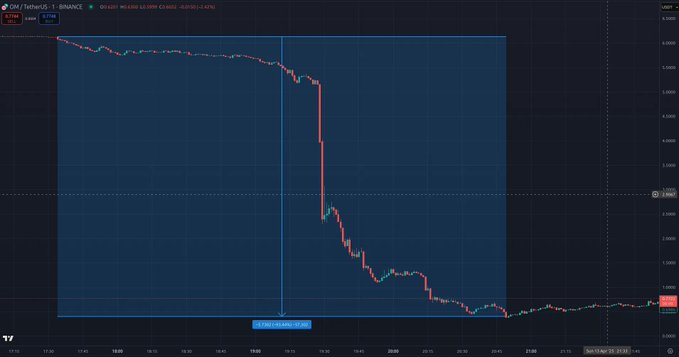
Market microstructure: Finding the origin of selling
We will focus mainly on the critical minutes of the plunge. Next, I will analyze a three-minute period, and for the sake of clarity, I divided it into three parts.
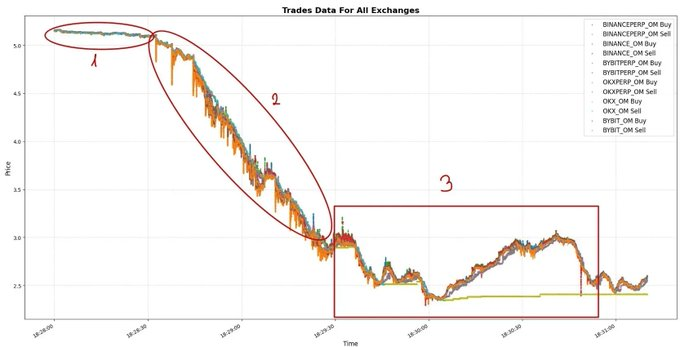
In the first phase, the market experienced a slight but noteworthy selling pressure. This pressure is mainly concentrated in the perpetual contract markets of Binance and Bybit, as these platforms provide traders with the most convenient short selling channels.
Remember: you can create selling pressure without holding spot currency. Perpetual contracts are actually a more preferred option for large-scale directional investments, thanks to their high liquidity and leverage characteristics.
The second step is the most critical because it determines the significance of the entire event. Let us analyze it carefully.
First, from a macro perspective:
Although Binance Perpetual Contracts have the deepest liquidity on the market, the market impact (i.e., price volatility caused by a single market order) is far greater than any other exchange.
This phenomenon conveys key information:
The main funds planning this round of selling are mainly active in the Binance perpetual contract market.
how so? There may be two reasons:
- Each round of price fluctuations was first launched by Binance Perpetual Contract. In fact, the platform always dominates the market trends (it will be dismantled in detail later);
- Even with the support of deep liquidity, huge market orders still triggered severe price fluctuations, resulting in other market participants not having time to react or withdraw orders.
The following is evidence at the micro data level:
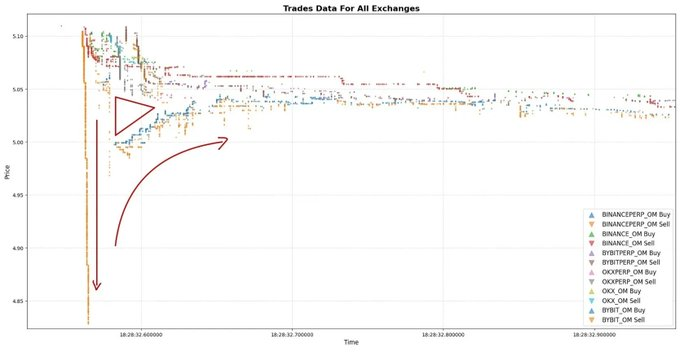
Here is a classic case in the field of high-frequency trading. A trader has the ability to sell large-scale shorts compared to market liquidity. We observe that trading on the order of $1 million every 5 seconds occurs in a specific time period (18:29:00, 18:29:10, 18:29:15). This high-frequency rhythm trading behavior clearly reflects the characteristics of institutional-level high-frequency trading strategies.
OK, the current situation is: a well-funded market participant is frantically shorting OM tokens, and its selling force seems to be coming. Obviously, every market sell order will trigger a huge market impact (about 5% fluctuation), but this impact is only temporary, just the immediate price impact of the trading moment.
The market will then return to the short-term price equilibrium state. This process will create a liquidity gap between exchanges (in a triangular pattern), that is, the transaction price of a trading platform is significantly lower than the fair market price.
This is why in the Binance Perpetual Contract Market, most of the capital flows after each large market order are actually just the market is looking for a equilibrium state again or transmitting the price signal to other exchanges.
Even though there is a strong selling pressure in the market, there is only one real pusher: someone controls every tiny fluctuation of OM on the Binance Perpetual Contract (actually not that "small").
We have seen a lot of similar situations. As you can see, this pattern is almost the same: Binance perpetual contracts take the lead, with other exchanges following behind.
We will encounter huge instantaneous market shocks, followed by liquidity gaps, and eventually form short-term equilibrium.
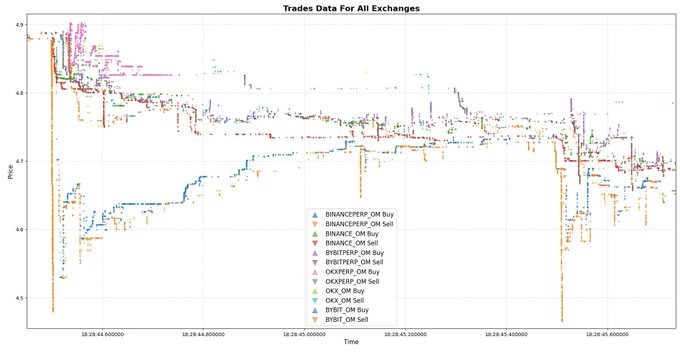
Again, the same pattern happened. I hope you like this kind of charts as much as I do. After all, to be honest, whenever I see such a work, my heart will be filled with turmoil. This is pure art.
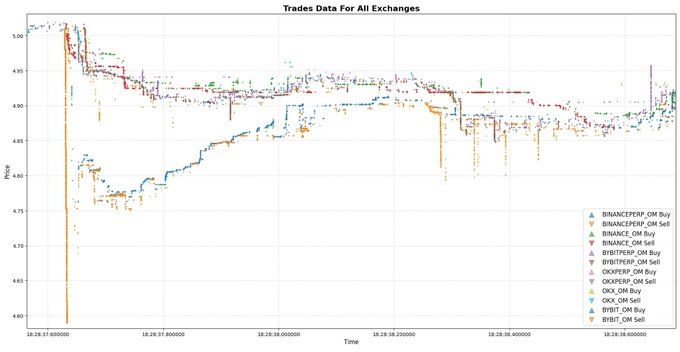
After a series of similar events, nearly 4 million OM tokens were shorted in a completely unprofessional, dirty and chaotic way. The attack was obviously carefully planned because it operates quickly, savagely and does not consider costs at all.
But then, things began to get weird.
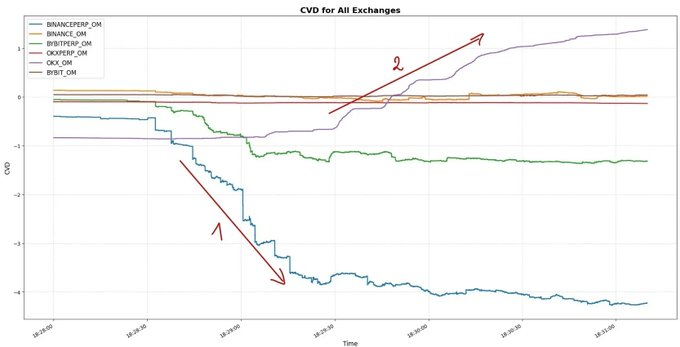
On our cumulative volume difference (CVD) screen, the OM token holdings of Binance Perpetual Contract is -4 million, while on the OKX platform (when Binance price bottomed out), its CVD continues to rise.
Unfortunately, at this time these exchange data began to be misleading. Not just you, many very smart analysts are also misled.
This is exactly what I said on Twitter today, and it is extremely difficult to draw clear conclusions from transaction data. This data is almost always incomplete. You have no way of knowing who the market participants are, nor what their intentions are. All you see is the appearance, and your analysis is to get as close to the truth as possible.
At this moment, I can tell you with certainty: within the next 120 seconds, a certain OKX user will launch an unprecedented crazy sale. The fierce selling force may break through your cognitive boundaries.
Fasten your seat belt and the next things will be even more exciting!
Let's take a look at the third part of the initial plot.
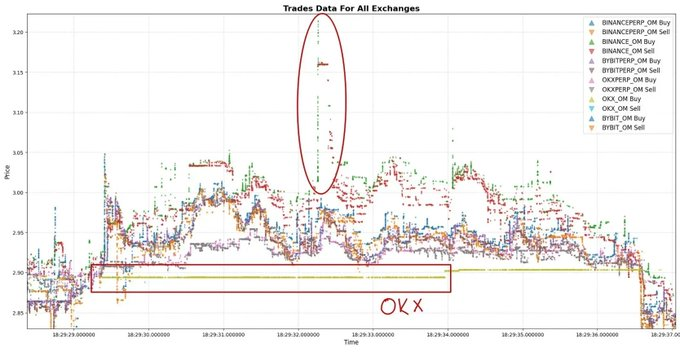
One minute after the OM sell-off began, the price had plummeted by 50% from its starting point, and at this moment, someone suddenly appeared out of thin air, and we will call it "OKX OM-Giant Whale".
This "giant whale" began to place market-price sell limit orders at a few percentage points below the top of the order book. In a blink of an eye, the transaction price on the OKX exchange was much lower than that of other platforms.
You've known the reason for a long time, right? There is currently a huge limit selling order: millions of OM tokens are waiting to be sold.
This is why CVD is positive, not because the market is buying frantically, but because one participant is selling heavily while other participants take the opportunity to conduct arbitrage operations. They buy in OKX spot market and short hedging in the perpetual contract market or other spot platforms.
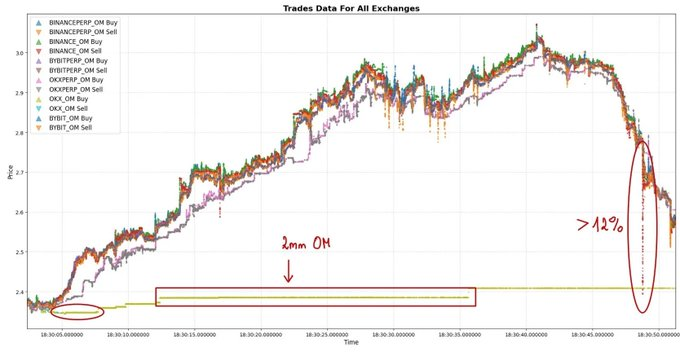
Even on the OKX exchange, there is a separate 2 million OM limit order, which keeps the price unchanged for a full minute. And that's the only reason you see CVD showing a positive trend.
It's not because people are buying frantically, but because some (most likely only one) market participants sell out all the assets they can sell.
You can view order volumes in the top 10 levels of each exchange order book here.
Have you noticed all outliers?
Yes, the seller is always OKX.
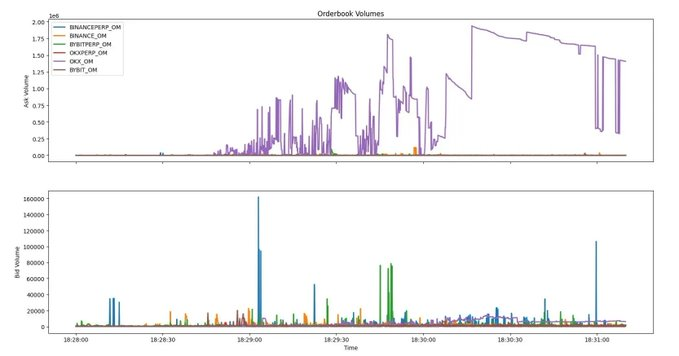
There are only two possibilities left:
- Either the market participant was forced to sell (or they would be in serious trouble)
- Either he is fully aware of the market trend and realizes it's time to clear the position now
These executable limit orders do not look like they were pre-planned or executed by algorithms.
It feels like a decision that hastily been made within a minute of the sale, and the person who makes the decision has no other choice.
What is the second possibility?
They have long known the inside story of OM. When they saw the selling wave of that scale, they immediately realized that the collapse had begun, so they rushed to evacuate while they could still get out.
"But how could such a thing happen?"
There are some speculations circulating on the X platform. One of the most notable statements is that the OM project team has allegedly encouraged some trading companies to provide them with USDT loans with OM tokens as collateral.
How does this statement fit into the script of "Death Spiral"?
Imagine such an operation:
- Pledge OM as collateral and you borrow USDT
- Deposit USDT to Binance Exchange
- Brutal shorting of OM through perpetual contracts. This method is not clever, but with the overwhelming position scale, it has caused market collapse and chaos, triggered a series of liquidation
- In the end, the price of the currency was cut in half.
This script is completely true.
I'm talking about the facts? Not so. We have no conclusive evidence, only scattered clues and patterned behavioral trajectories.
The OM giant whale on the OKX platform may be:
- A user who was forced to sell due to loan terms or risk control red lines
- Participants in this hunt
- Or the OTC institution that has made a fortune in OM but has not withdrawn in time will suddenly wake up and take action when the situation takes a sharp turn.
At this moment, the story begins to slide in a treacherous direction:
Take a look at this Ethereum wallet: 0xEbb8B59780170833E455b32f57CF03DC440A77D2
It began pledging OM tokens 448 days ago and began receiving rewards six days before the market crash.
Let's take a look at this chart.
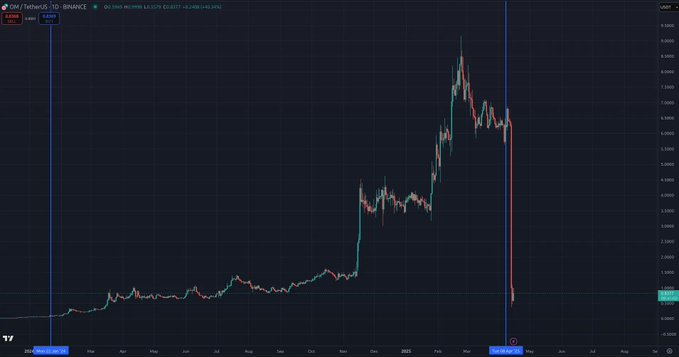
The time point is really clever. That wallet is associated with multiple transfers and a series of other wallets. But after several transfers, by tracking a certain link in the chain, we finally located the wallet 0xB37D...f26A, which is connected to an account marked "OKX recharge address". For more background information, please refer to this tweet , which can provide you with key clues.
It is very likely that this wallet, which started pledging 448 days ago and withdrew rewards a few days before the market crash, was actually the same person as the participant who frequently issued aggressive market limit orders on the OKX exchange.
We know it well, and Binance is likely to know the mastermind behind this attack.
According to data, the market participant who frantically suppressed the order book in the Binance Perpetual Contract market was the main driving force behind this avalanche sale.
That's all for now.


 chaincatcher
chaincatcher